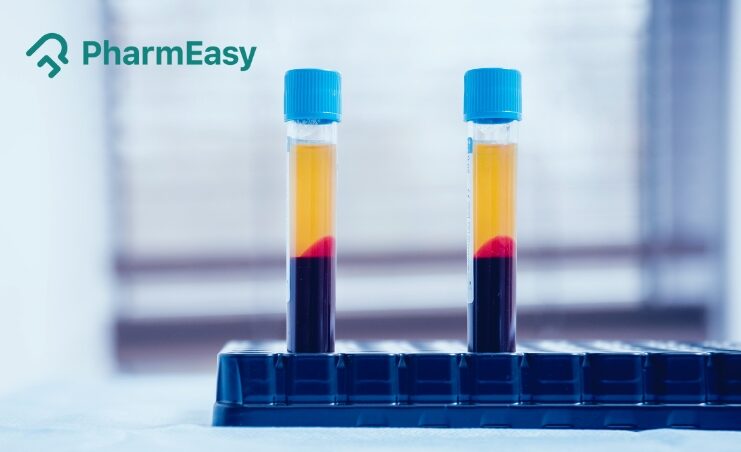Normal Platelet Count: Causes, Symptoms & Management of Abnormal Levels
By Dr. Nayana Shetty +2 more

Get,

to manage your symptom
Get your,


4 Cr+ families
benefitted

OTP sent to 9988776655



You’ve successfully subscribed to receive
doctor-approved tips on
Whatsapp

Get ready to feel your best.

Hi There,
Download the PharmEasy App now!!


Register to Avail the Offer
Send OTPBy continuing, you agree with our Privacy Policy and Terms and Conditions

Hi There,
Sign up on PharmEasy now!!
Trusted by 4 crore+ families

OTP sent to 9988776655



You have unlocked 25% off on medicines




Code: NU25
By Dr. Nayana Shetty +2 more
Table of Contents
A healthy platelet count is a vital aspect of our overall health, as it helps our blood clot appropriately in response to injury. Understanding the normal range of platelets is essential in detecting any imbalances or deviations from the norm that could lead to complications.
In this article we will discuss in detail about platelet counts, providing valuable information on what constitutes a normal range, as well as the factors that can affect these counts. We will explore the causes and symptoms of abnormal platelet counts and discuss the diagnostic and management options available. Lastly, we will touch upon the impact of the COVID-19 pandemic on platelet counts and how to maintain good health.

Did you know?
Platelets, also known as thrombocytes, are colourless, disc-shaped cell fragments that are produced in the bone marrow and circulate in the blood1. They play a significant role in maintaining our health by facilitating blood clotting and wound repair.
Our bone marrow produces platelets in a process named megakaryopoiesis. These platelets come from larger cells known as megakaryocytes1. They break off tiny fragments as they mature and form platelets.
Platelets perform several key roles, which are as follows.
When a blood vessel is damaged, platelets become active. They stick to the injured area and form a patch. They then release blood clot forming chemicals1. The result is a blood clot that stops the wound from bleeding and helps it heal.
It is important to know the normal range for platelet count and what factors may change this count.
The normal count of platelets in both adults and kids falls between 150–400×109/L of blood2. But research shows some small differences based on whether you’re male or female.
Parameters like age, gender, genes, and health issues can all affect platelet count.
A complete blood count (CBC) test can provide vital data about your platelets.
Abnormal platelet counts can be a result of a few issues. This could be because of health problems, medicine, and various other causes.
If your platelet count dips below 150,000/mcL, this is known as thrombocytopenia3. The cause might be that the body isn’t making enough platelets, or too many platelets might be destroyed or stored up in certain organs.
You may have an inherited or acquired platelet disease such as Bernard-Soulier Syndrome (BSS) if the findings of your platelet function test are abnormal. You may inherit genetic illnesses from your family. Although the abnormalities exist from birth, symptoms might not appear until later in life. Disorders that are acquired do not exist at birth. They might be brought on by medications, environmental exposure, or other illnesses. There are instances where the cause is unclear9.
Dr. Siddharth Gupta, B.A.M.S, M.D
A platelet count above 450,000/mcL is known as thrombocytosis4. This count could be due to an innate issue with the bone marrow or it could be due to an external factor or another health problem.
A few things can result in high platelet counts. These are as follows4.
The signs that point to abnormal platelet counts can be different. It depends on whether the platelet count is high or low.
Signs of thrombocytopenia could include the following5:
Often, people with a high platelet count don’t notice any symptoms. But sometimes, those with thrombocytosis may have abnormal bruising or bleeding. A high platelet count may also be associated with a higher risk of blood clots. Warning signs like headache, dizziness, chest pain or numbness must be watched out for6.
If you notice signs of a platelet disorder, you must discuss it with your doctor. Unstoppable bleeding or signs similar to a heart attack or stroke calls for immediate medical help.
Finding the cause of altered platelet count is key to managing it well.
To find out if a person has a low platelet count, a health expert will take a thorough medical history and perform a physical examination. They’ll also review the person’s past medical issues. Further tests like blood tests or bone marrow aspiration and biopsy may be advised if needed.
Management for unusual platelet counts will depend on how severe the condition is and its root cause. Management options may include the following8:
For individuals with abnormal platelet counts, an important part of management is avoiding risky activities which may cause injuries that bleed. Keeping track of their platelet levels and discussing personal and family histories as well as any medicines or health aids being taken with the doctor is also essential. This can help find possible causes and make informed decisions about management.
Also Read: Low Platelet Count – Symptoms, Causes & Treatment
Abnormal platelet counts can result in serious, even life-threatening, problems.
If a person’s platelet count falls below 20,000/mcL, dangerous internal bleeding can happen5. Severe thrombocytopenia can lead to bleeding in the brain. This can be deadly.
When platelet count is too high, it can cause blood clots to form. This can lead to deep vein thrombosis, blockage in the lung (pulmonary embolism), myocardial infarction or stroke4. These can be life-threatening as well.
Also Read: 7 Things You Need to Avoid in Anaemia!
Understanding the importance of keeping a healthy platelet count is crucial for best health. If we understand the signs of abnormal platelet counts and seek timely medical advice, we may be able to manage any health issues impacting our platelets.
Regular screenings including routine doctor visits and timely blood testing are important for all individuals to detect abnormal platelet counts or any other issues at an early stage and avoid future complications.
Also Read: Causes of Low Platelet Count & Tips for Improving Them
Usually, platelet count for adults and kids is between 150,000 and 450,000/mcL of blood.
An unsafe platelet count will depend on your unique conditions. But in general, a count below 150,000/mcL is low and raises bleeding risks. A count above 450,000/mcL is high and raises clot formation risks.
Having a platelet count of 140,000/mcL is a little on the lower side. The normal range is between 150,000 and 450,000/mcL. But a slightly low count may not show symptoms or need urgent medical care. Yet, in case of any doubt, it’s best to see your doctor and get personalised guidance.
Yes, a count of 70,000/mcL is low as it’s below the normal range of 150,000 to 450,000/mcL. This count points to thrombocytopenia and raises the risk of bleeding. Always consult a health expert to find the cause and the right management.
Disclaimer: The information provided here is for educational/awareness purposes only and is not intended to be a substitute for medical treatment by a healthcare professional and should not be relied upon to diagnose or treat any medical condition. The reader should consult a registered medical practitioner to determine the appropriateness of the information and before consuming any medication. PharmEasy does not provide any guarantee or warranty (express or implied) regarding the accuracy, adequacy, completeness, legality, reliability or usefulness of the information; and disclaims any liability arising thereof.
Comments

Leave your comment...
You may also like
Comments